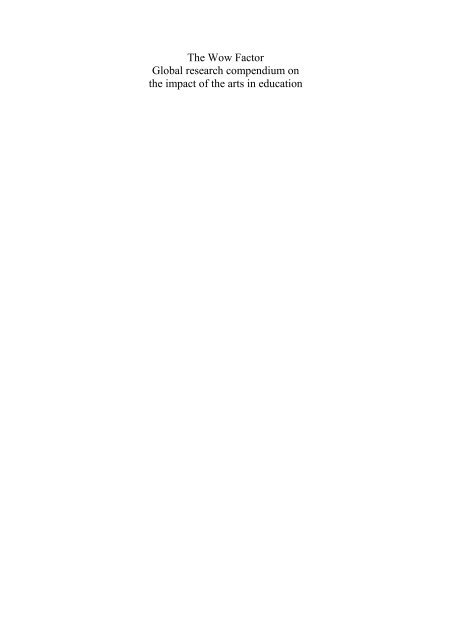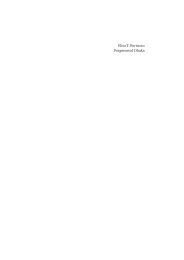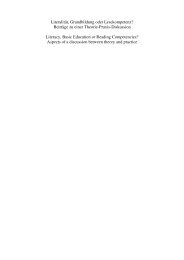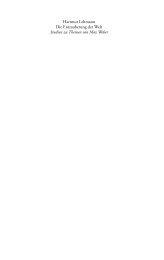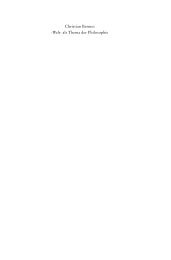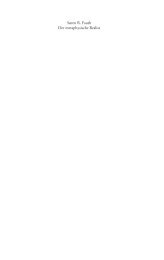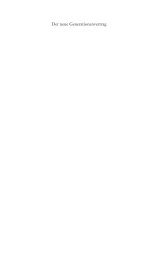The Wow Factor Global research compendium on the ... - E-cademic
The Wow Factor Global research compendium on the ... - E-cademic
The Wow Factor Global research compendium on the ... - E-cademic
Create successful ePaper yourself
Turn your PDF publications into a flip-book with our unique Google optimized e-Paper software.
<str<strong>on</strong>g>The</str<strong>on</strong>g> <str<strong>on</strong>g>Wow</str<strong>on</strong>g> <str<strong>on</strong>g>Factor</str<strong>on</strong>g><br />
<str<strong>on</strong>g>Global</str<strong>on</strong>g> <str<strong>on</strong>g>research</str<strong>on</strong>g> <str<strong>on</strong>g>compendium</str<strong>on</strong>g> <strong>on</strong><br />
<strong>the</strong> impact of <strong>the</strong> arts in educati<strong>on</strong><br />
1
Anne Bamford<br />
<str<strong>on</strong>g>The</str<strong>on</strong>g> <str<strong>on</strong>g>Wow</str<strong>on</strong>g> <str<strong>on</strong>g>Factor</str<strong>on</strong>g><br />
<str<strong>on</strong>g>Global</str<strong>on</strong>g> <str<strong>on</strong>g>research</str<strong>on</strong>g> <str<strong>on</strong>g>compendium</str<strong>on</strong>g> <strong>on</strong><br />
<strong>the</strong> impact of <strong>the</strong> arts in educati<strong>on</strong><br />
Waxmann Münster / New York<br />
München / Berlin<br />
3
Bibliographic informati<strong>on</strong> published by Die Deutsche Biblio<strong>the</strong>k<br />
Die Deutsche Biblio<strong>the</strong>k lists this publicati<strong>on</strong> in <strong>the</strong><br />
Deutsche Nati<strong>on</strong>albibliografie; detailed bibliographic data<br />
are available in <strong>the</strong> Internet at http://dnb.ddb.de.<br />
ISBN 978-3-8309-1617-8<br />
Sec<strong>on</strong>d editi<strong>on</strong>, 2009<br />
© Anne Bamford<br />
Waxmann Verlag GmbH, 2006<br />
Postfach 8603, D–48046 Münster<br />
www.waxmann.com<br />
info@waxmann.com<br />
Cover Design: Christian Averbeck, Münster<br />
Credits: Collecti<strong>on</strong> Projeto Presente<br />
Children playing selfmade musical instruments free in nature where <strong>the</strong>y<br />
bel<strong>on</strong>g. This image shows <strong>on</strong>e of <strong>the</strong> fun tours through “Morro da Pedreira”<br />
(Envir<strong>on</strong>mental Protected Area) where <strong>the</strong> majority of <strong>the</strong> participants of<br />
Projeto Presente live. After making and building <strong>the</strong> instruments using<br />
pieces of garbage and natural materials <strong>the</strong>re is nothing else better than to join<br />
in and learn surrounded by <strong>the</strong> beauty of <strong>the</strong> countryside where <strong>the</strong>y bel<strong>on</strong>g!<br />
Typesetting: Stoddart Satz- und Layoutservice, Münster<br />
Print: Druckerei Hubert & Co., Göttingen<br />
Printed <strong>on</strong> age-resistant paper, DIN 6738<br />
All rights reserved<br />
Printed in Germany<br />
4
For Angus, Nina, Lachlan, Daniel and<br />
all <strong>the</strong> o<strong>the</strong>r children in <strong>the</strong> world<br />
5
C<strong>on</strong>tents<br />
Executive summary......................................................................................................... 9<br />
Acknowledgements ....................................................................................................... 15<br />
Preface........................................................................................................................... 17<br />
Chapter 1:<br />
<str<strong>on</strong>g>The</str<strong>on</strong>g> arts are intrinsic...................................................................................................... 19<br />
Chapter 2:<br />
Social, political and historical c<strong>on</strong>text for thinking about arts educati<strong>on</strong>..................... 29<br />
Chapter 3:<br />
Underpinning <str<strong>on</strong>g>research</str<strong>on</strong>g> .................................................................................................. 41<br />
Chapter 4:<br />
<str<strong>on</strong>g>The</str<strong>on</strong>g> scope and nature of arts educati<strong>on</strong>......................................................................... 47<br />
Chapter 5:<br />
Arts educati<strong>on</strong> in practice.............................................................................................. 73<br />
Chapter 6:<br />
Goals and indicati<strong>on</strong>s of quality in arts-rich educati<strong>on</strong>................................................. 85<br />
Chapter 7:<br />
<str<strong>on</strong>g>The</str<strong>on</strong>g> impact of arts educati<strong>on</strong> ....................................................................................... 103<br />
Chapter 8:<br />
C<strong>on</strong>clusi<strong>on</strong>s and future directi<strong>on</strong>s............................................................................... 139<br />
References ................................................................................................................... 151<br />
Index............................................................................................................................ 155<br />
Appendix One: Copy of survey................................................................................... 157<br />
Appendix Two: List of resp<strong>on</strong>ding countries, ministries and/or organisati<strong>on</strong>s .......... 172<br />
Appendix Three: Case study titles listed by country .................................................. 176<br />
Appendix Four: O<strong>the</strong>r countries also c<strong>on</strong>sulted (not survey resp<strong>on</strong>dents) ................. 178<br />
7
Executive summary<br />
<str<strong>on</strong>g>The</str<strong>on</strong>g> <str<strong>on</strong>g>Wow</str<strong>on</strong>g> <str<strong>on</strong>g>Factor</str<strong>on</strong>g>: <str<strong>on</strong>g>Global</str<strong>on</strong>g> <str<strong>on</strong>g>research</str<strong>on</strong>g> perspectives <strong>on</strong> <strong>the</strong> impact of <strong>the</strong> arts in educati<strong>on</strong><br />
reports <strong>the</strong> findings of a UNESCO project, carried out in collaborati<strong>on</strong> with <strong>the</strong><br />
Australia Council for <strong>the</strong> Arts (<str<strong>on</strong>g>The</str<strong>on</strong>g> Council) and <strong>the</strong> Internati<strong>on</strong>al Federati<strong>on</strong> of<br />
Arts Councils and Culture Agencies (IFACCA).<br />
This executive summary briefly reviews our methods and findings. <str<strong>on</strong>g>The</str<strong>on</strong>g> first<br />
chapter of <strong>the</strong> book presents <strong>the</strong> background and <strong>the</strong> c<strong>on</strong>text for <strong>the</strong> report, including<br />
an overview of central issues.<br />
<str<strong>on</strong>g>The</str<strong>on</strong>g> following chapters present an analysis of wide-ranging data collected regarding<br />
<strong>the</strong> extent and impact of arts-rich programmes <strong>on</strong> children and young people.<br />
Based <strong>on</strong> findings of a comprehensive survey c<strong>on</strong>ducted in 2004 and distributed to<br />
ministries of educati<strong>on</strong> and culture in <strong>the</strong> UNESCO membership countries (as well<br />
as by organisati<strong>on</strong>s of which <strong>the</strong>se hold joint-membership, e.g. <strong>the</strong> European<br />
Council).<br />
Acknowledging that a quantitative analysis can give but a partial understanding of<br />
<strong>the</strong> field, selected (representative) case studies of arts-rich programmes in over 35<br />
countries have been used to exemplify issues.<br />
<str<strong>on</strong>g>The</str<strong>on</strong>g> c<strong>on</strong>cluding chapter draws all <strong>the</strong> observati<strong>on</strong>s toge<strong>the</strong>r for an overall sense of<br />
how <strong>the</strong> different arts-rich programmes can be characterized and compared, and<br />
includes recommendati<strong>on</strong>s about how – and to what extent – <strong>the</strong>se may be improved<br />
up<strong>on</strong> in <strong>the</strong> future. <str<strong>on</strong>g>The</str<strong>on</strong>g> appendices at <strong>the</strong> end of this book present some of<br />
<strong>the</strong> data that was collected from each country, al<strong>on</strong>g with o<strong>the</strong>r relevant informati<strong>on</strong><br />
such as details of <strong>the</strong> case studies that can be accessed <strong>on</strong>line.<br />
This book was written in c<strong>on</strong>sultati<strong>on</strong> with an internati<strong>on</strong>al team of experts <strong>on</strong> arts,<br />
educati<strong>on</strong> and social sciences. <str<strong>on</strong>g>The</str<strong>on</strong>g> internati<strong>on</strong>al team was led by Professor Anne<br />
Bamford, Director of <str<strong>on</strong>g>The</str<strong>on</strong>g> Engine Room, Wimbled<strong>on</strong> School of Art, L<strong>on</strong>d<strong>on</strong>. <str<strong>on</strong>g>The</str<strong>on</strong>g><br />
internati<strong>on</strong>al team investigated and evaluated worldwide standards of arts-rich educati<strong>on</strong><br />
in order to understand <strong>the</strong> current trends and examples of best-practice<br />
models in <strong>the</strong> field.<br />
Objectives<br />
<str<strong>on</strong>g>The</str<strong>on</strong>g> commissi<strong>on</strong>ed <str<strong>on</strong>g>research</str<strong>on</strong>g> underpinning <strong>the</strong> findings in this book aimed to establish<br />
an internati<strong>on</strong>al <str<strong>on</strong>g>compendium</str<strong>on</strong>g> <strong>on</strong> <str<strong>on</strong>g>research</str<strong>on</strong>g> dem<strong>on</strong>strating <strong>the</strong> impact of arts-rich<br />
programmes <strong>on</strong> <strong>the</strong> educati<strong>on</strong> of children and young people around <strong>the</strong> world.<br />
9
In order to assess <strong>the</strong> impact of arts-rich programmes, <strong>the</strong> qualitative and quantitative<br />
informati<strong>on</strong> ga<strong>the</strong>red from <strong>the</strong> extensive survey distributed in November 2004<br />
was analysed. <str<strong>on</strong>g>The</str<strong>on</strong>g> following questi<strong>on</strong>s guided <strong>the</strong> analysis:<br />
How was <strong>the</strong> teaching of arts-rich programmes organised?<br />
Who are resp<strong>on</strong>sible for curriculum development and implementati<strong>on</strong> of artsrich<br />
programmes?<br />
What are <strong>the</strong> differences between <strong>the</strong> arts-rich programmes taught in <strong>the</strong> different<br />
countries?<br />
What determines <strong>the</strong> differences in c<strong>on</strong>tent from country to country?<br />
What can be expected or recommended of arts-rich programmes in <strong>the</strong> future?<br />
Methods<br />
To address <strong>the</strong>se broad <str<strong>on</strong>g>research</str<strong>on</strong>g> questi<strong>on</strong>s, <strong>the</strong> study focused <strong>on</strong> two main aspects:<br />
1. Establishing a knowledge-base about <strong>the</strong> organisati<strong>on</strong>al frameworks and o<strong>the</strong>r<br />
c<strong>on</strong>diti<strong>on</strong>s which regulate and structure <strong>the</strong> teaching of arts-rich programmes,<br />
and;<br />
2. Applicati<strong>on</strong> of qualitative and quantitative methods of analysis aimed at drawing<br />
c<strong>on</strong>clusi<strong>on</strong>s about <strong>the</strong> role of arts-rich programmes in different countries.<br />
Carrying out this <str<strong>on</strong>g>research</str<strong>on</strong>g> presented methodological challenges. On <strong>the</strong> <strong>on</strong>e hand, it<br />
was necessary to use a relatively tight definiti<strong>on</strong> of <strong>the</strong> arts in order to ga<strong>the</strong>r overall<br />
comparable informati<strong>on</strong> about <strong>the</strong> extent, c<strong>on</strong>tent, and impact of <strong>the</strong> different<br />
programmes. On <strong>the</strong> o<strong>the</strong>r hand, <strong>the</strong>se definiti<strong>on</strong>s were often too narrow to capture<br />
<strong>the</strong> full extend of <strong>the</strong> programmes.<br />
Arts educati<strong>on</strong> – as defined in <strong>the</strong> quantitative part of <strong>the</strong> project – aim:<br />
To pass <strong>on</strong> cultural heritage to young people, and;<br />
To enable <strong>the</strong>m to create <strong>the</strong>ir own artistic language and to c<strong>on</strong>tribute to <strong>the</strong>ir<br />
global development (emoti<strong>on</strong>al and cognitive).<br />
<str<strong>on</strong>g>The</str<strong>on</strong>g>se definiti<strong>on</strong>s, as stated above, cannot stand al<strong>on</strong>e. A work of art is an object<br />
that embodies a meaning. As Arthur Danto has said “nothing is an artwork without<br />
an interpretati<strong>on</strong> that c<strong>on</strong>stitutes it as such” 1 . What is seen as art in <strong>on</strong>e culture is<br />
not defined as such in ano<strong>the</strong>r.<br />
Given this, quantitative findings were interpreted through direct reference to qualitative<br />
case studies. Resp<strong>on</strong>dents of <strong>the</strong> survey were also provided with opportunities<br />
for citing examples of pertinent case studies and, in general, invited to give<br />
examples of programmes that fall outside <strong>the</strong> definiti<strong>on</strong> of arts employed in this<br />
study.<br />
1 Danto quoted in Cynthia Freeland (2001) Art <str<strong>on</strong>g>The</str<strong>on</strong>g>ory, Oxford, Oxford University Press, p. 38.<br />
10
C<strong>on</strong>clusi<strong>on</strong>s/Observati<strong>on</strong>s<br />
C<strong>on</strong>taining resp<strong>on</strong>ses from over 40 countries and organizati<strong>on</strong>s, <strong>the</strong> book provides<br />
a global overview of <strong>the</strong> qualities of effective arts and educati<strong>on</strong> partnerships, including:<br />
Identifiable details of <strong>the</strong> impact of arts and educati<strong>on</strong> partnerships, and;<br />
Models of data collecti<strong>on</strong> and <str<strong>on</strong>g>research</str<strong>on</strong>g> methodology for investigating <strong>the</strong> impact<br />
of arts and educati<strong>on</strong> partnerships.<br />
<str<strong>on</strong>g>The</str<strong>on</strong>g> overall findings of <strong>the</strong> <str<strong>on</strong>g>research</str<strong>on</strong>g> can be summarized as follows:<br />
<str<strong>on</strong>g>The</str<strong>on</strong>g> arts appear in <strong>the</strong> educati<strong>on</strong>al policy in almost every country in <strong>the</strong> world;<br />
<str<strong>on</strong>g>The</str<strong>on</strong>g>re is a gulf between <strong>the</strong> ‘lip service’ given to arts educati<strong>on</strong> and <strong>the</strong> provisi<strong>on</strong>s<br />
provided within schools;<br />
<str<strong>on</strong>g>The</str<strong>on</strong>g> term ‘arts educati<strong>on</strong>’ is culture and c<strong>on</strong>text specific. <str<strong>on</strong>g>The</str<strong>on</strong>g> meaning of <strong>the</strong><br />
term varies from country and country, with specific differences between ec<strong>on</strong>omically<br />
developed and ec<strong>on</strong>omically developing countries;<br />
In all countries – irrespective of <strong>the</strong>ir level of ec<strong>on</strong>omic development – certain<br />
core subjects (e.g. drawing and music – but also painting and craft) were part of<br />
<strong>the</strong> curriculum;<br />
Ec<strong>on</strong>omically developed countries tend to embrace new media (including film,<br />
photography, and digital art) in <strong>the</strong> curriculum;<br />
In ec<strong>on</strong>omically developing countries greater emphasis is placed <strong>on</strong> culture specific<br />
arts (e.g. stilt walking in Barbados, and hair-styling in Senegal!);<br />
<str<strong>on</strong>g>The</str<strong>on</strong>g>re is a difference between, what can be termed, educati<strong>on</strong> in <strong>the</strong> arts (e.g.<br />
teaching in fine arts, music, drama, crafts, etc.) and educati<strong>on</strong> through <strong>the</strong> arts<br />
(e.g. <strong>the</strong> use of arts as a pedagogical tool in o<strong>the</strong>r subjects, such as numeracy,<br />
literacy and technology);<br />
Arts educati<strong>on</strong> has impact <strong>on</strong> <strong>the</strong> child, <strong>the</strong> teaching and learning envir<strong>on</strong>ment,<br />
and <strong>on</strong> <strong>the</strong> community;<br />
<str<strong>on</strong>g>The</str<strong>on</strong>g>re is a need for more training for key providers at <strong>the</strong> coalface of <strong>the</strong> delivery-chain<br />
(e.g. teachers, artists, and o<strong>the</strong>r pedagogical staff);<br />
Quality arts educati<strong>on</strong> has distinct benefits for children’s health and socio-cultural<br />
well-being;<br />
Benefits of arts-rich programmes are <strong>on</strong>ly tangible within high quality programmes<br />
(though no specific definiti<strong>on</strong> of what c<strong>on</strong>stituted such programmes<br />
were given, aspects of quality can be inferred from <strong>the</strong> data), and;<br />
Quality arts educati<strong>on</strong> tends to be characterised by a str<strong>on</strong>g partnership between<br />
<strong>the</strong> schools and outside arts and community organisati<strong>on</strong>s. (In o<strong>the</strong>r words it is<br />
teachers, artists and <strong>the</strong> communities, which toge<strong>the</strong>r share <strong>the</strong> resp<strong>on</strong>sibility<br />
for <strong>the</strong> delivery of <strong>the</strong> programmes).<br />
11
Quality Educati<strong>on</strong> and Educati<strong>on</strong> for All: <str<strong>on</strong>g>The</str<strong>on</strong>g> role of <strong>the</strong> arts<br />
12<br />
Before answering <strong>the</strong> survey, I would like to share with <strong>the</strong> coordinators<br />
<strong>the</strong> idea of Arts Educati<strong>on</strong> as a double dimensi<strong>on</strong> process - ‘Educati<strong>on</strong> to<br />
<strong>the</strong> Arts’ and ‘Educati<strong>on</strong> by <strong>the</strong> Arts’. Thus it places <strong>the</strong> cultural coherence<br />
of <strong>the</strong> child at <strong>the</strong> heart of any educati<strong>on</strong>al strategy. Moreover, this<br />
visi<strong>on</strong> increases <strong>the</strong> value of all <strong>the</strong> disciplines and processes that have<br />
always been used by <strong>the</strong> communities – according to <strong>the</strong>ir own culture –<br />
to mould children’s identity through <strong>the</strong>ir emoti<strong>on</strong>al and cognitive predispositi<strong>on</strong>s.<br />
Hence <strong>the</strong> importance too of <strong>the</strong> social dimensi<strong>on</strong> of Arts<br />
Educati<strong>on</strong> which protects poor children from being marginalized from<br />
<strong>the</strong> educati<strong>on</strong>al system.<br />
2004: Alioune Badiane, Ministry for Culture and Heritage, Senegal<br />
A major finding of <strong>the</strong> <str<strong>on</strong>g>research</str<strong>on</strong>g> has been that <strong>the</strong>re are well-<str<strong>on</strong>g>research</str<strong>on</strong>g>ed and documented<br />
impacts of arts-rich educati<strong>on</strong>. As <strong>the</strong> quote from Senegal suggests, <strong>the</strong>se<br />
fall under two distinct aspects, respectively: Educati<strong>on</strong> in <strong>the</strong> arts and Educati<strong>on</strong><br />
through <strong>the</strong> arts.<br />
<str<strong>on</strong>g>The</str<strong>on</strong>g> former can be described as being sustained and systematic learning in <strong>the</strong><br />
skills, ways of thinking and presentati<strong>on</strong> of each of <strong>the</strong> art forms – dancing, visual<br />
arts, music, drama – and produces impacts in terms of improved attitudes to school<br />
and learning, enhanced cultural identity and sense of pers<strong>on</strong>al satisfacti<strong>on</strong> and wellbeing.<br />
C<strong>on</strong>currently, educati<strong>on</strong> which uses creative and artistic pedagogies to teach<br />
all curricula, i.e. educati<strong>on</strong> through <strong>the</strong> arts – enhances overall a<strong>cademic</strong> attainment,<br />
reduces school disaffecti<strong>on</strong> and promotes positive cognitive transfer. <str<strong>on</strong>g>The</str<strong>on</strong>g>se<br />
noted benefits are <strong>on</strong>ly accrued where <strong>the</strong>re were provisi<strong>on</strong>s of quality programmes.<br />
Poor quality programmes, were seen to actively inhibit <strong>the</strong> benefits<br />
apparent in good quality programmes.<br />
<str<strong>on</strong>g>The</str<strong>on</strong>g> aim of this book <str<strong>on</strong>g>The</str<strong>on</strong>g> <str<strong>on</strong>g>Wow</str<strong>on</strong>g> <str<strong>on</strong>g>Factor</str<strong>on</strong>g>: <str<strong>on</strong>g>Global</str<strong>on</strong>g> <str<strong>on</strong>g>research</str<strong>on</strong>g> <str<strong>on</strong>g>compendium</str<strong>on</strong>g> <strong>on</strong> <strong>the</strong> impact<br />
of <strong>the</strong> arts in educati<strong>on</strong> is to provide a significant body of analysed <str<strong>on</strong>g>research</str<strong>on</strong>g> that<br />
clearly documents <strong>the</strong> impacts of <strong>the</strong> arts within general educati<strong>on</strong>. By highlighting<br />
key examples of arts-rich educati<strong>on</strong> from around <strong>the</strong> world, it is intended that educati<strong>on</strong><br />
and arts and cultural organisati<strong>on</strong>s will be able to use this book to compare<br />
<strong>the</strong> policies and practices within <strong>the</strong>ir own countries. <str<strong>on</strong>g>The</str<strong>on</strong>g> book also provides insight<br />
into high quality arts-rich educati<strong>on</strong> practices around <strong>the</strong> world that can serve<br />
as models of practice for teachers, artists and preservice educators working in a<br />
range of c<strong>on</strong>texts.<br />
<str<strong>on</strong>g>The</str<strong>on</strong>g> <str<strong>on</strong>g>Wow</str<strong>on</strong>g> <str<strong>on</strong>g>Factor</str<strong>on</strong>g>: <str<strong>on</strong>g>Global</str<strong>on</strong>g> <str<strong>on</strong>g>research</str<strong>on</strong>g> <str<strong>on</strong>g>compendium</str<strong>on</strong>g> <strong>on</strong> <strong>the</strong> impact of <strong>the</strong> arts in educati<strong>on</strong><br />
is <strong>the</strong> first comprehensive analysis of <str<strong>on</strong>g>research</str<strong>on</strong>g>-based case studies from around<br />
<strong>the</strong> world. It makes a major c<strong>on</strong>tributi<strong>on</strong> to scholarly inquiry into <strong>the</strong> field of arts
educati<strong>on</strong> and will form a baseline of informati<strong>on</strong> for arts and educati<strong>on</strong> policy<br />
makers. <str<strong>on</strong>g>The</str<strong>on</strong>g> findings c<strong>on</strong>tained within this book <str<strong>on</strong>g>The</str<strong>on</strong>g> <str<strong>on</strong>g>Wow</str<strong>on</strong>g> <str<strong>on</strong>g>Factor</str<strong>on</strong>g>: <str<strong>on</strong>g>Global</str<strong>on</strong>g> <str<strong>on</strong>g>research</str<strong>on</strong>g><br />
<str<strong>on</strong>g>compendium</str<strong>on</strong>g> <strong>on</strong> <strong>the</strong> impact of <strong>the</strong> arts in educati<strong>on</strong> will become <strong>the</strong> standard by<br />
which <strong>the</strong> quality of arts-rich educati<strong>on</strong> programmes will be determined. As a result<br />
of foregrounding <strong>the</strong> importance of <strong>the</strong> arts within general educati<strong>on</strong> it is hoped that<br />
<strong>the</strong> children of <strong>the</strong> world may so<strong>on</strong> receive <strong>the</strong>ir full educati<strong>on</strong>al and artistic entitlements.<br />
13
Acknowledgements<br />
This book is <strong>the</strong> direct result of an extensive <str<strong>on</strong>g>research</str<strong>on</strong>g> study commissi<strong>on</strong>ed by<br />
UNESCO and carried out in collaborati<strong>on</strong> with <strong>the</strong> Australia Council for <strong>the</strong> Arts<br />
and <strong>the</strong> Internati<strong>on</strong>al Federati<strong>on</strong> of Arts Councils and Culture Agencies (IFACCA).<br />
This book would not have been possible without <strong>the</strong> funding and support provided<br />
by <strong>the</strong>se three organisati<strong>on</strong>s. In particular, I would like to thank Teresa Wagner<br />
(UNESCO) for her visi<strong>on</strong> and c<strong>on</strong>fidence to initiate this study and Christina<br />
Human (UNESCO) for her friendship, encouragement and help.<br />
Without <strong>the</strong> tremendous intellectual and administrative backing provided by Sarah<br />
Gardner (IFACCA), Christopher Madden (IFACCA), Gillian Gardiner (Australia<br />
Council for <strong>the</strong> Arts) and Samira Hassan (Australia Council for <strong>the</strong> Arts) <strong>the</strong> broad<br />
scope and global nature of <strong>the</strong> <str<strong>on</strong>g>research</str<strong>on</strong>g> would not have been possible.<br />
<str<strong>on</strong>g>The</str<strong>on</strong>g> critical provisi<strong>on</strong> offered by <strong>the</strong> arts educati<strong>on</strong> reference group (Michael<br />
Anders<strong>on</strong>, University of Sydney; Arnold Aprill, Chicago Arts Partnerships in Educati<strong>on</strong>;<br />
Gillian Gardiner, Australia Council for <strong>the</strong> Arts; Sarah Gardner, Internati<strong>on</strong>al<br />
Federati<strong>on</strong> of Arts Councils & Cultural Agencies; Maureen O’Rourke,<br />
Victorian Schools Innovati<strong>on</strong> Commissi<strong>on</strong>; Rod Parnall, Victorian Department of<br />
Educati<strong>on</strong> and Training; Robin Pascoe, Nati<strong>on</strong>al Affiliati<strong>on</strong> of Arts Educators;<br />
Barbara Piscitelli, Queensland University of Technology; Sim<strong>on</strong> Spain, ArtPlay –<br />
City of Melbourne; and, Tereza Wagner, UNESCO) was invaluable in ensuring a<br />
globally inclusive <str<strong>on</strong>g>research</str<strong>on</strong>g> design and a clearly delineated <str<strong>on</strong>g>research</str<strong>on</strong>g> base.<br />
<str<strong>on</strong>g>The</str<strong>on</strong>g> design of <strong>the</strong> impact measurement surveys, quantitative data analysis and<br />
policy interpretati<strong>on</strong> was <strong>the</strong> result of <strong>the</strong> expert advice given by Professor Matt<br />
Qvortrup, <str<strong>on</strong>g>The</str<strong>on</strong>g> Robert Gord<strong>on</strong> University, Aberdeen and I wish to thank him for<br />
his extensive commitment to <strong>the</strong> value of <strong>the</strong> arts within educati<strong>on</strong> and public<br />
policy.<br />
Finally, I wish to acknowledge <strong>the</strong> substantial intellectual c<strong>on</strong>tributi<strong>on</strong> made by all<br />
<strong>the</strong> survey resp<strong>on</strong>dents and providers of case studies. <str<strong>on</strong>g>The</str<strong>on</strong>g> openness with which<br />
policy makers, arts and educati<strong>on</strong> providers and practiti<strong>on</strong>ers were willing to share<br />
<strong>the</strong>ir <str<strong>on</strong>g>research</str<strong>on</strong>g> and experiences is testament to <strong>the</strong> collegiality of people from around<br />
<strong>the</strong> world who share <strong>the</strong> desire to make <strong>the</strong> arts a valued part of every child’s educati<strong>on</strong>.<br />
15
Preface<br />
<str<strong>on</strong>g>The</str<strong>on</strong>g> <str<strong>on</strong>g>Wow</str<strong>on</strong>g> <str<strong>on</strong>g>Factor</str<strong>on</strong>g>: <str<strong>on</strong>g>Global</str<strong>on</strong>g> <str<strong>on</strong>g>research</str<strong>on</strong>g> <str<strong>on</strong>g>compendium</str<strong>on</strong>g> <strong>on</strong> <strong>the</strong> impact of <strong>the</strong> arts in educati<strong>on</strong><br />
is <strong>the</strong> direct outcome of <strong>the</strong> UNESCO <str<strong>on</strong>g>research</str<strong>on</strong>g> project instigated to determine<br />
<strong>the</strong> impact of <strong>the</strong> arts within global educati<strong>on</strong>. This <str<strong>on</strong>g>research</str<strong>on</strong>g> was c<strong>on</strong>ducted in close<br />
collaborati<strong>on</strong> with <strong>the</strong> Australia Council for <strong>the</strong> Arts (<str<strong>on</strong>g>The</str<strong>on</strong>g> Council) and <strong>the</strong> Internati<strong>on</strong>al<br />
Federati<strong>on</strong> of Arts Councils and Culture Agencies (IFACCA). <str<strong>on</strong>g>The</str<strong>on</strong>g> commissi<strong>on</strong>ed<br />
<str<strong>on</strong>g>research</str<strong>on</strong>g> underpinning this book aimed to collate and analyse internati<strong>on</strong>al<br />
<str<strong>on</strong>g>research</str<strong>on</strong>g> dem<strong>on</strong>strating <strong>the</strong> impact (if any) of arts-rich programmes <strong>on</strong> <strong>the</strong><br />
educati<strong>on</strong> of children and young people around <strong>the</strong> world.<br />
In order to assess <strong>the</strong> impact of arts-rich programmes, <strong>the</strong> qualitative and quantitative<br />
informati<strong>on</strong> ga<strong>the</strong>red was analysed to determine both overall global patterns<br />
and <strong>the</strong> way arts educati<strong>on</strong> is manifest in various countries. Examining all aspects<br />
of <strong>the</strong> policy and delivery of arts educati<strong>on</strong>, <strong>the</strong> <str<strong>on</strong>g>research</str<strong>on</strong>g> design began by investigating<br />
policy formati<strong>on</strong> and curriculum development. This work was expanded<br />
through <strong>the</strong> detailed case studies that provided insight into <strong>the</strong> way <strong>the</strong>se policies<br />
were enacted and <strong>the</strong> complexities of implementati<strong>on</strong> of arts policy within <strong>the</strong> educati<strong>on</strong><br />
sector. In a specific way, teaching and learning experiences were examined<br />
and issues such as teacher educati<strong>on</strong>, resources and limitati<strong>on</strong>s were highlighted.<br />
<str<strong>on</strong>g>The</str<strong>on</strong>g>se factors were all c<strong>on</strong>sidered within a framework of impact analysis that<br />
looked at <strong>the</strong> range of possible outcomes attributable to <strong>the</strong> arts and evidenced<br />
within detailed <str<strong>on</strong>g>research</str<strong>on</strong>g> studies. <str<strong>on</strong>g>The</str<strong>on</strong>g>se effects were analysed in broad terms and<br />
ranged from <strong>the</strong> impacts <strong>on</strong> children and <strong>the</strong>ir learning, through impacts <strong>on</strong> percepti<strong>on</strong>s<br />
of schools and community and ultimately to examining major impacts <strong>on</strong><br />
intellectual, social, cultural and emoti<strong>on</strong>al well-being.<br />
To address <strong>the</strong>se <str<strong>on</strong>g>research</str<strong>on</strong>g> issues, <strong>the</strong> methodology chosen was predicated <strong>on</strong> <strong>the</strong><br />
need to establish a knowledge-base about <strong>the</strong> organisati<strong>on</strong>al frameworks and o<strong>the</strong>r<br />
c<strong>on</strong>diti<strong>on</strong>s which regulate and structure arts-rich educati<strong>on</strong> programmes. This was<br />
achieved through <strong>the</strong> applicati<strong>on</strong> of mainly qualitative – but also quantitative –<br />
methods of analysis aimed at portraying <strong>the</strong> role and nature of arts-rich programmes<br />
in different countries.<br />
Carrying out this <str<strong>on</strong>g>research</str<strong>on</strong>g> presented methodological challenges. On <strong>the</strong> <strong>on</strong>e hand, it<br />
was necessary to use a relatively tight definiti<strong>on</strong> of <strong>the</strong> arts in order to ga<strong>the</strong>r overall<br />
informati<strong>on</strong> about <strong>the</strong> extent, c<strong>on</strong>tent, and impact of <strong>the</strong> different programmes.<br />
On <strong>the</strong> o<strong>the</strong>r hand, <strong>the</strong>se definiti<strong>on</strong>s were often too narrow to capture <strong>the</strong> full extend<br />
of <strong>the</strong> programmes. Within this <str<strong>on</strong>g>research</str<strong>on</strong>g> a broad definiti<strong>on</strong> of arts educati<strong>on</strong><br />
was derived from <strong>the</strong> countries <strong>the</strong>mselves. At <strong>the</strong> heart of all <strong>the</strong> definiti<strong>on</strong>s was<br />
<strong>the</strong> noti<strong>on</strong> that an arts-rich model of educati<strong>on</strong> is endowed with provisi<strong>on</strong>s that<br />
serve to develop cultural heritage for young people and enable <strong>the</strong>m to create <strong>the</strong>ir<br />
17
own artistic language and to c<strong>on</strong>tribute to <strong>the</strong>ir global development (emoti<strong>on</strong>al and<br />
cognitive).<br />
<str<strong>on</strong>g>The</str<strong>on</strong>g>se definiti<strong>on</strong>s cannot stand al<strong>on</strong>e. What is seen as art in <strong>on</strong>e culture is not<br />
defined as such in ano<strong>the</strong>r. Given this, quantitative findings were interpreted<br />
through direct reference to qualitative case studies. Resp<strong>on</strong>dents were provided<br />
with opportunities for citing examples of pertinent case studies and, in general,<br />
invited to give examples of programmes that fall outside <strong>the</strong> more traditi<strong>on</strong>al<br />
definiti<strong>on</strong> of <strong>the</strong> arts.<br />
By taking an open and inclusive approach to <strong>the</strong> c<strong>on</strong>siderati<strong>on</strong> of arts-rich programmes<br />
within educati<strong>on</strong>, it was inevitable that questi<strong>on</strong>s could be asked about <strong>the</strong><br />
types of programmes included as falling under <strong>the</strong> ‘arts’ banner. <str<strong>on</strong>g>The</str<strong>on</strong>g> <str<strong>on</strong>g>research</str<strong>on</strong>g><br />
adopted an all-encompassing stance and did not attempt to make value judgements in<br />
relati<strong>on</strong> to <strong>the</strong> merits of <strong>on</strong>e art form over ano<strong>the</strong>r. To this extent, <strong>the</strong> global <str<strong>on</strong>g>research</str<strong>on</strong>g><br />
underpinning this book is testament to <strong>the</strong> diverse nature of <strong>the</strong> arts, yet within this<br />
multiplicity <strong>the</strong>re are clear patterns in terms of quality provisi<strong>on</strong>s and <strong>the</strong> impact of<br />
<strong>the</strong>se worthy programmes. This became <strong>the</strong> focus of <strong>the</strong> investigati<strong>on</strong>s.<br />
<str<strong>on</strong>g>The</str<strong>on</strong>g> noti<strong>on</strong> of “<strong>the</strong> wow factor” in educati<strong>on</strong> was a term that appeared in <strong>the</strong> qualitative<br />
comments c<strong>on</strong>tained within <strong>the</strong> surveys. This term was applied to mean <strong>the</strong><br />
excitement and unexpected results that are difficult to be definitive about but have<br />
enormous impact <strong>on</strong> <strong>the</strong> teachers, artists, children and even communities where<br />
effective arts-rich educati<strong>on</strong> occurred. This term was used especially in relati<strong>on</strong> to<br />
<strong>the</strong> children’s artistic achievements. <str<strong>on</strong>g>The</str<strong>on</strong>g> chance that a child may make a new discovery,<br />
open <strong>the</strong>ir eyes visually, musically or through movement or drama for <strong>the</strong><br />
first time, or produce some new and innovative resp<strong>on</strong>se was <strong>the</strong> engine that<br />
powered many arts-rich educati<strong>on</strong> programmes. <str<strong>on</strong>g>The</str<strong>on</strong>g> unexpected ‘wow factor’ was<br />
a potent force that kept teachers, artists and children going in arts programmes<br />
despite often severe structural restricti<strong>on</strong>s and difficulties associated with implementing<br />
art within particular c<strong>on</strong>text. This quote from an Australian artist/teacher<br />
describes <strong>the</strong> ‘wow’ factor – an impact which surpasses all impacts that may be<br />
more formally measured.<br />
18<br />
I mean every school you do it at, you get a different style…every kid<br />
gets a different result and you can be enthusiastic about that and say,<br />
“WOW!” You know… I haven’t seen that <strong>on</strong>e before. I think <strong>the</strong> “wow”<br />
part is really important. One of <strong>the</strong> young teachers at <strong>on</strong>e school was<br />
saying I sound just like you. I was saying, “<str<strong>on</strong>g>Wow</str<strong>on</strong>g>! Isn’t that great …?<br />
Look at this… That is fantastic” Something like that and I thought, “Oh<br />
that is good, I’ve started ano<strong>the</strong>r teacher teaching that way! It is good.
Chapter 1:<br />
<str<strong>on</strong>g>The</str<strong>on</strong>g> arts are intrinsic<br />
Introducti<strong>on</strong><br />
<str<strong>on</strong>g>The</str<strong>on</strong>g> arts are an intrinsic part of <strong>the</strong> way humans operate in <strong>the</strong> world. <str<strong>on</strong>g>The</str<strong>on</strong>g>re is<br />
evidence of <strong>the</strong> arts existing l<strong>on</strong>g before writing. Examples of art have been dated<br />
to pre-history as in <strong>the</strong> case of Australian Aboriginal art. People participate in <strong>the</strong><br />
arts all over <strong>the</strong> world. All cultures sing, dance, recite, listen to tales, and put <strong>on</strong><br />
performances. <str<strong>on</strong>g>The</str<strong>on</strong>g> arts have always been part of humanity’s most vital c<strong>on</strong>cerns.<br />
All societies in <strong>the</strong> world engage actively in <strong>the</strong> art, and <strong>the</strong> arts are flourishing in<br />
modern society as we rely even more str<strong>on</strong>gly up<strong>on</strong> <strong>the</strong>ir powers to get our<br />
message across.<br />
Children are born aes<strong>the</strong>tically aware and <strong>the</strong>y engage in <strong>the</strong> arts l<strong>on</strong>g before <strong>the</strong>y<br />
can speak or write. If you watch young children at play, you will see <strong>the</strong>m naturally<br />
communicating in artistic forms. Through <strong>the</strong> arts, youth c<strong>on</strong>struct meaning into a<br />
unified form. <str<strong>on</strong>g>The</str<strong>on</strong>g> arts emphasise how phenomena relate to each o<strong>the</strong>r. Holistic<br />
thinking and syn<strong>the</strong>sis of ideas are fundamental to <strong>the</strong> future world. Given this<br />
view, <strong>the</strong> arts are fundamental to educati<strong>on</strong> as a means to provide students with <strong>the</strong><br />
social and intellectual survival skills for <strong>the</strong> unforeseeable future.<br />
If we look to <strong>the</strong> future, <strong>the</strong> growing importance of technology has led to a renaissance<br />
of interest in <strong>the</strong> arts. C<strong>on</strong>temporary aes<strong>the</strong>tic culture goes bey<strong>on</strong>d what we<br />
would previously have termed ‘art’ or ‘<strong>the</strong> arts’. As <strong>the</strong> impact of <strong>the</strong> arts <strong>on</strong> communicati<strong>on</strong>,<br />
technology and meaning making grows, our schools need to focus <strong>on</strong><br />
arts-rich educati<strong>on</strong> that encourages critical thinking, problem solving, and reflecti<strong>on</strong>.<br />
<str<strong>on</strong>g>The</str<strong>on</strong>g> new reality is <strong>the</strong> critical and aes<strong>the</strong>tic realm of learning.<br />
In our ec<strong>on</strong>omy today, inventiveness, design and innovati<strong>on</strong> are necessary for survival.<br />
Innovati<strong>on</strong> demands that ideas are free flowing, which in turn requires that<br />
people be creatively and well educated. <str<strong>on</strong>g>The</str<strong>on</strong>g> young people of today will be <strong>the</strong><br />
inventors of <strong>the</strong> new cultural patterns and social philosophies of tomorrow. <str<strong>on</strong>g>The</str<strong>on</strong>g>y<br />
will need to be able to design <strong>the</strong> materials, c<strong>on</strong>diti<strong>on</strong>s, and community to fit this<br />
new world. To achieve this, young people require sustained and sequential learning<br />
both within and through <strong>the</strong> arts.<br />
Aligned with this, school reform will see <strong>the</strong> rec<strong>on</strong>figurati<strong>on</strong> of schools to become<br />
less bound by <strong>the</strong> physical walls of <strong>the</strong> school and to increasingly become centres<br />
for c<strong>on</strong>necting <strong>the</strong> child with a range of learning resources. <str<strong>on</strong>g>The</str<strong>on</strong>g> Internet has<br />
fundamentally changed <strong>the</strong> way we communicate and access knowledge. Students<br />
can more readily access informati<strong>on</strong> from galleries, museums and <strong>the</strong> broader educati<strong>on</strong>al<br />
community. In accordance with this trend, schools should extend <strong>the</strong> class-<br />
19
oom boundaries to include art and cultural instituti<strong>on</strong>s and be flexible with timetables<br />
and o<strong>the</strong>r structures to allow students to become immersed in <strong>the</strong>ir investigati<strong>on</strong>s.<br />
<str<strong>on</strong>g>The</str<strong>on</strong>g> arts have an enormous part to play in <strong>the</strong> total experience of educati<strong>on</strong> that<br />
students receive. Students develop greatly in terms of risk-taking, c<strong>on</strong>fidence, and<br />
ownership of learning through involvement in <strong>the</strong> arts. <str<strong>on</strong>g>The</str<strong>on</strong>g> arts really are involving;<br />
<strong>the</strong>y promote a sense of community through a shared sprit and encourage student<br />
motivati<strong>on</strong> to learn. Through establishing c<strong>on</strong>necti<strong>on</strong>s with students, <strong>the</strong> arts offer<br />
something unique and intrinsic to <strong>the</strong> quality of educati<strong>on</strong>.<br />
<str<strong>on</strong>g>The</str<strong>on</strong>g> arts directly c<strong>on</strong>tribute to positive self-percepti<strong>on</strong>s and identity, vital to effective<br />
educati<strong>on</strong>al achievement and <strong>the</strong> pursuit of lifel<strong>on</strong>g learning. <str<strong>on</strong>g>The</str<strong>on</strong>g> arts may<br />
assist in developing cultural awareness and <strong>the</strong> acceptance of self and o<strong>the</strong>rs.<br />
Recent technological changes have also sparked c<strong>on</strong>siderable interest in <strong>the</strong> impact<br />
of <strong>the</strong> arts <strong>on</strong> students’ learning in relati<strong>on</strong> to emerging multimodal literacies.<br />
Despite all <strong>the</strong>se claimed benefits of <strong>the</strong> arts, educati<strong>on</strong> m<strong>on</strong>itoring and issues of<br />
quality have still largely c<strong>on</strong>centrated <strong>on</strong> achievement defined by quite limited<br />
noti<strong>on</strong>s of scientific, ma<strong>the</strong>matical or technological thinking and <strong>the</strong> cultural<br />
dimensi<strong>on</strong> of educati<strong>on</strong> has been largely overlooked. This problem is compounded<br />
by a lack of sustained evidence of <strong>the</strong> benefits of arts-rich programmes <strong>on</strong> educati<strong>on</strong>al<br />
outcomes and definiti<strong>on</strong>al problems associated with <strong>the</strong> scope and nature<br />
of arts educati<strong>on</strong> as it is operates within schools.<br />
Arts educati<strong>on</strong> involves<br />
<str<strong>on</strong>g>The</str<strong>on</strong>g> term ‘arts’ is used to denote both instructi<strong>on</strong> in <strong>the</strong> arts and artistic pedagogy<br />
used to instigate educati<strong>on</strong>. Richards<strong>on</strong> (1999: 25) defines <strong>the</strong> arts broadly and<br />
simply as being anything made by humans. Embedded within this definiti<strong>on</strong> are a<br />
number of assumpti<strong>on</strong>s. Richards<strong>on</strong> c<strong>on</strong>tends that <strong>the</strong> arts involve skills in creating<br />
something that is beautiful and/or moving in its form. He c<strong>on</strong>siders that <strong>the</strong> arts are<br />
c<strong>on</strong>structed and sited within a cultural c<strong>on</strong>text. Definiti<strong>on</strong>s of <strong>the</strong> arts c<strong>on</strong>tinue to<br />
be <strong>the</strong> subject of entire <strong>the</strong>ories, and it is not <strong>the</strong> intenti<strong>on</strong> of this book to add to that<br />
extensive body of work. <str<strong>on</strong>g>The</str<strong>on</strong>g>re is c<strong>on</strong>siderable questi<strong>on</strong>ing over whe<strong>the</strong>r a term<br />
such as <strong>the</strong> arts – with <strong>the</strong> ‘s’ – is even an appropriate way to group disciplines<br />
whose paramount forms can be as diverse as portraiture, orchestra, ballet and Greek<br />
tragedy. Yet <strong>the</strong> dominant political and educati<strong>on</strong>al discourses widely use <strong>the</strong> term<br />
‘<strong>the</strong> arts’ and embed within this term an assumpti<strong>on</strong> of unity underpinned by<br />
noti<strong>on</strong>s of culture, heritage, citizenship and creativity.<br />
20
<str<strong>on</strong>g>The</str<strong>on</strong>g> first questi<strong>on</strong> <strong>the</strong> <str<strong>on</strong>g>research</str<strong>on</strong>g> underpinning this book asked was what was c<strong>on</strong>sidered<br />
as being part of arts educati<strong>on</strong> within <strong>the</strong> c<strong>on</strong>text of particular countries,<br />
and <strong>the</strong> resp<strong>on</strong>ses given yielded diverse, historical and yet c<strong>on</strong>temporary attempts<br />
to define <strong>the</strong> parameters of <strong>the</strong> areas of study loosely termed ‘<strong>the</strong> arts’. To accommodate<br />
this, an open and inclusive definiti<strong>on</strong> of <strong>the</strong> arts is adopted in this book. <str<strong>on</strong>g>The</str<strong>on</strong>g><br />
following were <strong>the</strong> definiti<strong>on</strong>s used in <strong>the</strong> survey:<br />
Glossary:<br />
Arts educati<strong>on</strong>:<br />
Arts educati<strong>on</strong> aims to pass <strong>on</strong> cultural heritage to young people, to enable<br />
<strong>the</strong>m to create <strong>the</strong>ir own artistic language and to c<strong>on</strong>tribute to <strong>the</strong>ir<br />
global development (emoti<strong>on</strong>al and cognitive). Arts educati<strong>on</strong> <strong>the</strong>refore<br />
affects <strong>the</strong> child <strong>on</strong> both an a<strong>cademic</strong> and pers<strong>on</strong>al level. 2 <str<strong>on</strong>g>The</str<strong>on</strong>g>re are two<br />
different approaches to Arts educati<strong>on</strong>: 3 Educati<strong>on</strong> in Art implies teaching<br />
<strong>the</strong> pupils <strong>the</strong> practices and principles of <strong>the</strong> various art disciplines,<br />
to stimulate <strong>the</strong>ir critical awareness and sensitiveness and to enable <strong>the</strong>m<br />
to c<strong>on</strong>struct cultural identities. Educati<strong>on</strong> through art implies that art is<br />
seen as a vehicle for learning o<strong>the</strong>r subject c<strong>on</strong>tent and a mean for<br />
teaching more general educati<strong>on</strong>al outcomes. O<strong>the</strong>r subjects should<br />
hence be infused into arts educati<strong>on</strong>, especially social or cultural issues.<br />
Internati<strong>on</strong>al <str<strong>on</strong>g>compendium</str<strong>on</strong>g>:<br />
This is a collecti<strong>on</strong> of c<strong>on</strong>cise but detailed informati<strong>on</strong> <strong>on</strong> projects being<br />
undertaken in various countries around <strong>the</strong> world that include <strong>the</strong> arts as<br />
a vital part of innovati<strong>on</strong>, learning and educati<strong>on</strong>. Will <strong>the</strong> <str<strong>on</strong>g>compendium</str<strong>on</strong>g><br />
c<strong>on</strong>tain analysis, or meta-analysis, as well as informati<strong>on</strong> <strong>on</strong> what is being<br />
d<strong>on</strong>e?<br />
Research:<br />
This survey adopts a broad definiti<strong>on</strong> of <str<strong>on</strong>g>research</str<strong>on</strong>g> that includes any<br />
systematic investigati<strong>on</strong> that attempts to explore <strong>the</strong> nature of <strong>the</strong> links<br />
between <strong>the</strong> arts and educati<strong>on</strong>. Research implies a ga<strong>the</strong>ring of data or<br />
material from a range of sources. It can include both traditi<strong>on</strong>al quantitative<br />
and qualitative methods and/or o<strong>the</strong>r informal or innovative<br />
approaches.<br />
2 Victor Flussel, teacher and director of <strong>the</strong> CMFI (Centre de Formati<strong>on</strong> pour Musiciens<br />
Intervenants) in Strasbourg.<br />
3 From <strong>the</strong> document “Sharing <strong>the</strong> Visi<strong>on</strong>: A Nati<strong>on</strong>al Framework for Arts Educati<strong>on</strong> in<br />
Canadian Schools” from <strong>the</strong> “Nati<strong>on</strong>al Symposium <strong>on</strong> Arts Educati<strong>on</strong>”, a Canadian virtual<br />
symposium designed to be a communicati<strong>on</strong> center and interactive envir<strong>on</strong>ment for arts<br />
educati<strong>on</strong> advocates, http://www.artsed.ca/Sharing_<strong>the</strong>_Visi<strong>on</strong>.PDF<br />
21
22<br />
Impact:<br />
Impact should be c<strong>on</strong>sidered in its broadest sense. Impact describes <strong>the</strong><br />
influence or effect of <strong>the</strong> project, <str<strong>on</strong>g>research</str<strong>on</strong>g>, policy or interventi<strong>on</strong>. It can<br />
also include <strong>the</strong> impressi<strong>on</strong> created or <strong>the</strong> attitudes fostered by a project.<br />
Impact can include (but not be limited to) impact <strong>on</strong> policy, funding,<br />
formal educati<strong>on</strong>, informal educati<strong>on</strong>, curriculum, teachers, preservice<br />
teachers, children, artists, family and <strong>the</strong> community. It can include ec<strong>on</strong>omic<br />
impact, social impact, cultural impact, spiritual impact, impact <strong>on</strong><br />
identity and many o<strong>the</strong>r forms of impact.<br />
Arts-rich programme:<br />
Any educati<strong>on</strong>al plan, curriculum, educati<strong>on</strong>al practice, model of teaching<br />
and learning that involves <strong>the</strong> arts in a significant and substantial way<br />
and has a direct impact <strong>on</strong> <strong>the</strong> educati<strong>on</strong> of children.<br />
Educati<strong>on</strong>al C<strong>on</strong>texts:<br />
While primarily examining arts-rich activities that occur within schools,<br />
this survey c<strong>on</strong>siders that educati<strong>on</strong> is any form of systematic instructi<strong>on</strong><br />
that involves teaching and learning. It is acknowledged that educati<strong>on</strong><br />
can occur in many locati<strong>on</strong>s and involves more than (but not excluding)<br />
<strong>the</strong> acquisiti<strong>on</strong> of numeracy and literacy. Under this definiti<strong>on</strong> of<br />
educati<strong>on</strong>, wisdom is engendered through skills, c<strong>on</strong>cepts, understandings<br />
and knowledge. Educati<strong>on</strong> is acknowledged to be a force in<br />
cultural development and to involve an understanding of traditi<strong>on</strong> and<br />
c<strong>on</strong>temporary and future society and practices.<br />
Children and young people:<br />
Any individual between <strong>the</strong> ages of 0 and 18 years of age.<br />
Marginalised or ‘at risk’ (children) in terms of fulfilling <strong>the</strong>ir educati<strong>on</strong>al<br />
and artistic potential:<br />
This refers to any children or young people for whom <strong>the</strong> established or<br />
regular patterns or offerings of formal educati<strong>on</strong> may be irrelevant,<br />
inappropriate and/or insignificant. Marginalised or ‘at risk’ children may<br />
feel unimportant, excluded and/or peripheral to educati<strong>on</strong>. <str<strong>on</strong>g>The</str<strong>on</strong>g>y may<br />
perceive <strong>the</strong>ir exposure to educati<strong>on</strong> as being of no c<strong>on</strong>sequence and irrelevant.<br />
Research Methodology:<br />
Any system of processes and techniques used to investigate <strong>the</strong> way art<br />
and educati<strong>on</strong> can be studied or examined. Methodology can include, but<br />
should not be limited to, both traditi<strong>on</strong>al and n<strong>on</strong>-traditi<strong>on</strong>al forms of<br />
data ga<strong>the</strong>ring and <str<strong>on</strong>g>research</str<strong>on</strong>g> inquiry. As part of <strong>the</strong> aim of <strong>the</strong> survey is to
eveal alternative and innovative arts <str<strong>on</strong>g>research</str<strong>on</strong>g> methodologies, we welcome<br />
inclusi<strong>on</strong> of a range of approaches.<br />
Appendix <strong>on</strong>e c<strong>on</strong>tains a copy of <strong>the</strong> survey distributed to resp<strong>on</strong>dents.<br />
Fur<strong>the</strong>rmore, <strong>the</strong> <str<strong>on</strong>g>research</str<strong>on</strong>g> attempted to not simply define arts educati<strong>on</strong> and explore<br />
its manifestati<strong>on</strong>s in practice, but to specifically examine what ‘quality’ arts educati<strong>on</strong><br />
may be. ‘Quality’, is defined as being those arts educati<strong>on</strong> provisi<strong>on</strong>s that are<br />
of recognised high value and worth in terms of <strong>the</strong> skills, attitudes and performativity<br />
engendered. According to Pearsall (1998) quality implies something<br />
that has been achieved successfully. In <strong>the</strong> case of this book, quality is c<strong>on</strong>sidered<br />
to exist as something that may include achievements, but goes bey<strong>on</strong>d this to<br />
c<strong>on</strong>sider learning journeys, pathways, partnerships and recogniti<strong>on</strong>. Dewey (1934:<br />
19) writes of quality as being characterised by a “heightened vitality.” He fur<strong>the</strong>r<br />
comments that quality signifies, “active and alert commerce with <strong>the</strong> world: at its<br />
height, it implies complete interpretati<strong>on</strong> of self and <strong>the</strong> world of objects and<br />
events.” Under this noti<strong>on</strong>, quality is not a fixed dispositi<strong>on</strong> but ra<strong>the</strong>r as Kissick<br />
(1993: 27) notes, “quality is first and foremost an idea, its criteria are susceptible to<br />
influences from within a given society.”<br />
Starting point for <strong>the</strong> <str<strong>on</strong>g>research</str<strong>on</strong>g><br />
<str<strong>on</strong>g>Global</str<strong>on</strong>g> m<strong>on</strong>itoring of educati<strong>on</strong>al standards has tended to focus <strong>on</strong> achievement in<br />
ma<strong>the</strong>matics, literacy and scientific thinking. <str<strong>on</strong>g>The</str<strong>on</strong>g>re are many anecdotal comments<br />
from children, teachers and parents that <strong>the</strong> arts have a major impact <strong>on</strong> schooling<br />
and learning. Yet sustained <str<strong>on</strong>g>research</str<strong>on</strong>g> <strong>on</strong> <strong>the</strong> global extent of this impact has been<br />
lacking. C<strong>on</strong>currently, even if such m<strong>on</strong>itoring of <strong>the</strong> artistic and cultural aspects of<br />
educati<strong>on</strong> were to occur, <strong>the</strong>re does not exist a set of standards that could be<br />
universally agreed as being evident of quality provisi<strong>on</strong>s for art educati<strong>on</strong>. <str<strong>on</strong>g>The</str<strong>on</strong>g><br />
qualities of c<strong>on</strong>summate – or frankly even adequate – arts educati<strong>on</strong> have been<br />
poorly articulated in <strong>the</strong> literature. Yet highly successful arts-rich programmes are<br />
apparent in case studies of everyday practices of arts educators and artists working<br />
in a range of educati<strong>on</strong>al c<strong>on</strong>texts. It was thus surmised that it may be possible to<br />
ascertain <strong>the</strong> salient qualities that inform principles and practice of effective artsrich<br />
programmes around <strong>the</strong> world and <strong>the</strong> impact <strong>the</strong>se successful programmes<br />
have. <str<strong>on</strong>g>The</str<strong>on</strong>g> combinati<strong>on</strong> of quantitative and qualitative methods applied in <strong>the</strong> global<br />
<str<strong>on</strong>g>research</str<strong>on</strong>g> <strong>on</strong> arts educati<strong>on</strong> was premised <strong>on</strong> <strong>the</strong> assumpti<strong>on</strong> that <strong>the</strong> elusive<br />
qualities apparent in effective arts-rich programmes in a range of c<strong>on</strong>texts may be<br />
embedded in case studies of quality practice. Detailed examinati<strong>on</strong> of case studies<br />
from around <strong>the</strong> world, given a range of educati<strong>on</strong>al, ec<strong>on</strong>omic and social c<strong>on</strong>texts<br />
provides a source of knowledge and enlightenment and sheds light <strong>on</strong> <strong>the</strong>ir beliefs,<br />
knowledge and practices relating to arts educati<strong>on</strong>.<br />
23
More broadly, arts educati<strong>on</strong> is a relatively neglected area for scholarly investigati<strong>on</strong>.<br />
As Zimmerman (1994: 60) notes, <strong>the</strong>re has been c<strong>on</strong>siderable neglect of <str<strong>on</strong>g>research</str<strong>on</strong>g><br />
and practices related to arts teachers. This lack of <str<strong>on</strong>g>research</str<strong>on</strong>g> impacts negatively<br />
up<strong>on</strong> future directi<strong>on</strong>s in arts educati<strong>on</strong>. Additi<strong>on</strong>ally, Zimmerman (1994:<br />
65) c<strong>on</strong>tends that teachers and artists need to be encouraged to find a voice and to<br />
be empowered to seek <strong>the</strong>ir own meaning and understandings as <strong>the</strong>y engage in <strong>the</strong><br />
practice of arts teaching. <str<strong>on</strong>g>The</str<strong>on</strong>g> results of <strong>the</strong> <str<strong>on</strong>g>research</str<strong>on</strong>g> have shown a clear gap<br />
between <strong>the</strong> espoused policy – that value <strong>the</strong> arts within educati<strong>on</strong> – and <strong>the</strong> actual<br />
‘in school’ practices, that tend to fall significantly below <strong>the</strong> lofty aims existing in<br />
policy.<br />
While substantial studies into <strong>the</strong> benefits of art educati<strong>on</strong> have been undertaken in<br />
<strong>the</strong> United States (USA), Canada, Australia, Finland, <strong>the</strong> United Kingdom (UK)<br />
and o<strong>the</strong>rs, a comprehensive analysis had not been c<strong>on</strong>ducted of global <str<strong>on</strong>g>research</str<strong>on</strong>g> in<br />
arts educati<strong>on</strong>. Despite a range of studies indicating <strong>the</strong> benefits of <strong>the</strong> arts, <strong>the</strong> arts<br />
remain undervalued in many countries.<br />
Organisati<strong>on</strong> of <strong>the</strong> book<br />
<str<strong>on</strong>g>The</str<strong>on</strong>g> overall structure of <strong>the</strong> book has been designed to look comprehensively at <strong>the</strong><br />
state of arts educati<strong>on</strong> at <strong>the</strong> current point in time. <str<strong>on</strong>g>The</str<strong>on</strong>g> book utilises <strong>the</strong> data from<br />
<strong>the</strong> survey to present a wide-ranging picture of arts-rich educati<strong>on</strong> around <strong>the</strong><br />
world. <str<strong>on</strong>g>The</str<strong>on</strong>g> rati<strong>on</strong>ale behind <strong>the</strong> original <str<strong>on</strong>g>research</str<strong>on</strong>g> is that it would be valuable to<br />
capture <strong>the</strong> current state-of-play in relati<strong>on</strong> to arts educati<strong>on</strong> around <strong>the</strong> world and<br />
open this up for discussi<strong>on</strong> so that at a local level teachers and artists <strong>the</strong>y may be<br />
able to communicate aspects of <strong>the</strong>ir practice and beliefs, and at a nati<strong>on</strong>al or state<br />
level ministries of educati<strong>on</strong>, arts and culture and educati<strong>on</strong>al and cultural agencies<br />
may be provided with inspirati<strong>on</strong> for models of future arts-rich educati<strong>on</strong>. It is <strong>the</strong><br />
c<strong>on</strong>tenti<strong>on</strong> of this book that through c<strong>on</strong>versati<strong>on</strong>s, it is possible to differentiate <strong>the</strong><br />
present from <strong>the</strong> future and to think how <strong>the</strong> present and <strong>the</strong> future are likely to<br />
differ. It is within a framework of future acti<strong>on</strong> and improvement that <strong>the</strong> <str<strong>on</strong>g>research</str<strong>on</strong>g><br />
– and resulting book – is c<strong>on</strong>ceived.<br />
Since, earlier attempts to enhance <strong>the</strong> quality of l<strong>on</strong>g-term, classroom based<br />
outcomes of arts-rich educati<strong>on</strong> programmes seem to have been largely ineffectual,<br />
<strong>the</strong> book provided an opportunity to ga<strong>the</strong>r large-scale data and yet allow for <strong>the</strong><br />
presentati<strong>on</strong> of case studies that encouraged <strong>the</strong> full involvement of teachers and<br />
artists. In presenting <strong>the</strong> meta-analysis, <strong>the</strong> book tries to combine <strong>the</strong> statistical data<br />
with <strong>the</strong> voice of <strong>the</strong> resp<strong>on</strong>dents so that equal attenti<strong>on</strong> is given to <strong>the</strong> ‘big picture’<br />
as to <strong>the</strong> educati<strong>on</strong>al ecology surrounding arts-rich practices. It was equally<br />
significant to investigate what was happening in arts educati<strong>on</strong> today in a global<br />
and nati<strong>on</strong>al level as it was to examine <strong>the</strong> ways teachers, artists and <strong>the</strong><br />
24
community organise <strong>the</strong>ir formal and informal ‘classrooms’ and <strong>the</strong> scope of <strong>the</strong><br />
programmes <strong>the</strong>y provide. <str<strong>on</strong>g>The</str<strong>on</strong>g>se localised case studies gave meaning to <strong>the</strong><br />
complexity – and at times c<strong>on</strong>fusing – overall data and enabled <strong>the</strong> revelati<strong>on</strong> of<br />
poignant aspects of <strong>on</strong> <strong>the</strong> ground operati<strong>on</strong>s that could be c<strong>on</strong>sidered to be <strong>the</strong><br />
qualities of effective arts-rich teaching and learning.<br />
<str<strong>on</strong>g>The</str<strong>on</strong>g> visi<strong>on</strong> of a future framework for quality arts-rich educati<strong>on</strong> is presupposed by<br />
<strong>the</strong> noti<strong>on</strong> that a depth arts curriculum is possible and that <strong>the</strong> arts are both<br />
learnable and teachable. It is assumed in this book that new methods might nurture<br />
and cultivate critical reflecti<strong>on</strong> within <strong>the</strong> arts educati<strong>on</strong> community and that <strong>the</strong><br />
setting of priorities and a <str<strong>on</strong>g>research</str<strong>on</strong>g> framework may assist in <strong>the</strong> development of arts<br />
educati<strong>on</strong> pedagogy.<br />
Creative and interpretive models of inquiry provide a multiplicity of ways of<br />
knowing. Bearing this in mind, <strong>the</strong> book is essentially a perspective <strong>on</strong> people,<br />
things or events surrounding global arts educati<strong>on</strong>. It is not an absolute answer to a<br />
questi<strong>on</strong> nor does it attempt to find <strong>the</strong> ultimate, single rule for acti<strong>on</strong>. This<br />
multiplicity of ways of knowing exists within a socio-cultural framework. You<br />
cannot isolate knowledge from <strong>the</strong> c<strong>on</strong>text that produces it.<br />
It was assumed that an art-based <str<strong>on</strong>g>research</str<strong>on</strong>g> paradigm was an appropriate and valid<br />
form of inquiry for this study. Artists and teachers tend to have an antipathy to<br />
positivist enterprises that dominate much global m<strong>on</strong>itoring of standards. Bearing<br />
this in mind, <strong>the</strong> book adopts an approach that aims to listen and see in an in-depth<br />
fashi<strong>on</strong>. Similarly, while more qualitative <str<strong>on</strong>g>research</str<strong>on</strong>g> methodologies have been<br />
chosen as having greatest applicability to this study, <strong>the</strong>se have not been viewed as<br />
<strong>the</strong> single, correct methodology and so <strong>the</strong> presentati<strong>on</strong> of findings begins in each<br />
secti<strong>on</strong> with a summary of key issues (presented as dot points), followed by<br />
summaries of <strong>the</strong> meta-analysis of key statistical informati<strong>on</strong>. <str<strong>on</strong>g>The</str<strong>on</strong>g> statistical data is<br />
<strong>the</strong>n explained and exemplified through specific qualitative resp<strong>on</strong>ses, examples at<br />
<strong>the</strong> nati<strong>on</strong>al or local level, and stories from teachers, children and artists. It is hoped<br />
that this combinati<strong>on</strong> of broad-based data and descriptive narrative allows issues to<br />
be fore grounded and patterns to emerge.<br />
Like a good artwork, <strong>the</strong>re are no simple predictable patterns. Aligned to both <strong>the</strong><br />
<str<strong>on</strong>g>research</str<strong>on</strong>g> and critique agendas, this study is both descriptive and analytical in nature<br />
and strives to expound up<strong>on</strong> <strong>the</strong> meanings inherent in nati<strong>on</strong>al policy and<br />
classroom practices. Yet to find <strong>the</strong>se at times elusive meanings, <strong>the</strong>mes have been<br />
used to organise <strong>the</strong> analysis. Just as <strong>on</strong>e would not judge a s<strong>on</strong>g against <strong>the</strong> same<br />
criteria as <strong>on</strong>e might judge a watercolour painting, <strong>the</strong> nature of <strong>the</strong> reporting<br />
process should align to <strong>the</strong> characteristics of what is being studied.<br />
25


